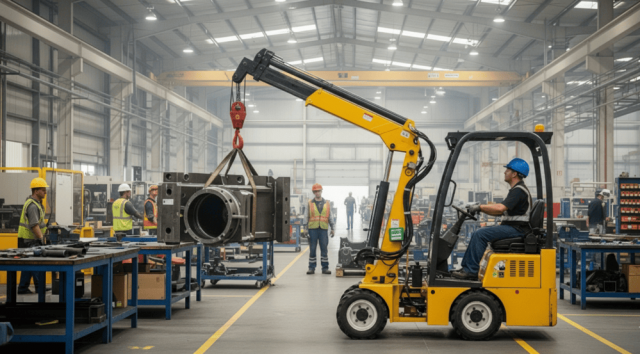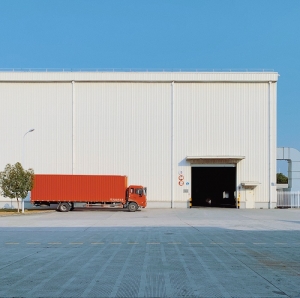With the growing demand, the modern manufacturing industry prefers machines that bring efficiency in day-to-day operations. There are several tasks to handle, from raw material handling to assembly, packaging, and dispatch. Delays or bottlenecks in moving heavy loads can cause downtime, safety risks, and productivity losses. Industrial cranes are thus becoming popular.
While machines are designed to lift and move heavy objects, they also help plants reduce manual labor, cut down operational delays, and maintain safety while handling bulky materials.
In this blog, we will explore what industrial cranes are, their common features and how selecting the right one can transform your plant's operational efficiency:
What is an Industrial Crane?
An industrial crane is a specialized machine that can lift, lower, and transport heavy materials horizontally. These are different from construction cranes, which are mostly mobile or tower-based. Manufacturers install industrial cranes within facilities such as warehouses, assembly lines, and production plants.
They are engineered to handle repetitive and demanding tasks, such as moving:
- Steel coils,
- Machinery parts,
- Raw materials, or
- Finished products.
You can operate these manually, semi-automatically, or fully automatically, depending on plant requirements.
Key Features of Industrial Cranes
Every manufacturing company has different requirements. So, you can't expect a one-size-fits-all industrial crane. They come with a range of features that make them adaptable to different industries, such as
- Depending on the size and power, an industrial crane can lift anywhere between a few hundred kilograms and several hundred tonnes. This makes them perfect for heavy-duty performance in demanding environments.
- Many cranes come with advanced control systems to ensure smooth lifting and precise placement of materials.
- As mentioned before, you can opt for one with manual, remote, or automated operation.
- Since they are made with high-strength steel, they can easily withstand rigorous daily use.
- Most industrial cranes are resistant to heat, dust, and industrial wear-and-tear.
- For some cranes, you can configure them based on your plant layout, e.g., single girder, double girder, gantry, jib, or overhead cranes. You can also add attachments like magnets, grabs, or hooks for specific needs.
- Industrial cranes are equipped with overload protection, emergency brakes, and anti-collision devices. This reduces workplace accidents and safeguards employees.
- Energy consumption is a serious factor for many manufacturing companies. Modern cranes are built with energy-efficient motors, regenerative braking systems, and optimized designs to reduce electricity consumption.
How Choosing the Right Industrial Crane Boosts Efficiency in Manufacturing Plants
Installing industrial cranes is not a light investment. So, it is normal to have high expectations. Here are a few points on how these cranes can improve operational efficiency for manufacturing plants:
1. Improves Your Workflow
Moving heavy-duty goods from one floor to another manually is not just time-consuming but also labor-intensive. But with an industrial crane, you don't need multiple handling stages with forklifts. These cranes lift loads straight from storage to the assembly line. This reduces bottlenecks and ensures a smoother production cycle.
2. Reduces Downtime
Manufacturers want to maintain a continuous workflow to deliver their product on time. But equipment breakdowns or delays in material handling often slow down production. High-quality cranes with advanced features minimize such interruptions. The modern cranes are also equipped with diagnostic tools that allow for predictive maintenance. This means you know when your machine needs maintenance and can reduce unscheduled downtime.
3. Improves Safety Standards
Manual lifting or improper load handling-related accidents are more common in manufacturing than you think. But thanks to industrial cranes, you can avoid these. Most machines come with safety features to reduce risks, such as
- Overload protection,
- Limit switches, and
- Anti-sway technology
This not only reduces accident rates but also makes your workers feel safe in their workplace.
4. Higher Load Capacity and Speed
Cranes can handle large loads, like a few tonnes in a single move. It is a completely different scenario from forklifts or manual methods. With these machines, you can increase your throughput of plants and scale up operations without increasing manpower. Since you adjust and control speed, it also helps balance efficiency with precision.
5. Better Space Utilization
Overhead and gantry cranes make use of vertical space, leaving the plant floor uncluttered. This is especially valuable in manufacturing plants where every inch of floor area matters. The right crane design ensures smooth load movement without interfering with other operations.
6. Customization for Specific Processes
When you are dealing with unique materials or workflows, you need special features. Industrial cranes can be customized, such as
- You can add magnets when dealing with steel sheets,
- Grabs for loose materials, or
- Vacuum lifters for glass panels
This helps you to maintain speed and efficiency without spending a huge amount on purchasing completely new machinery.
7. Energy and Cost Efficiency
Energy and cost are factors every manufacturer looks at first before making an investment. When you choose an industrial crane with energy-efficient motors and optimized designs, it reduces power consumption. Plus, reducing manual labor and minimizing accidents also means that your operational costs will be reduced. If you think about the overall expense,rather than just the upfront costs, investing in the right crane pays back through both savings and higher output.
8. Supports Automation and Industry 4.0
Many modern cranes can be integrated with automation systems and IoT devices. They can be remotely monitored, programmed for repetitive tasks, and linked with plant management software. This supports the shift toward smart manufacturing and future-proof operations.
Wrap Up
Time has changed for brands to meet the demands and stay on par with their competitors; they need reliable machines. Industrial cranes offer multiple advantages, including efficiency, productivity, and low operating costs. So, you have nothing to lose when you choose a crane that fits your requirements.






